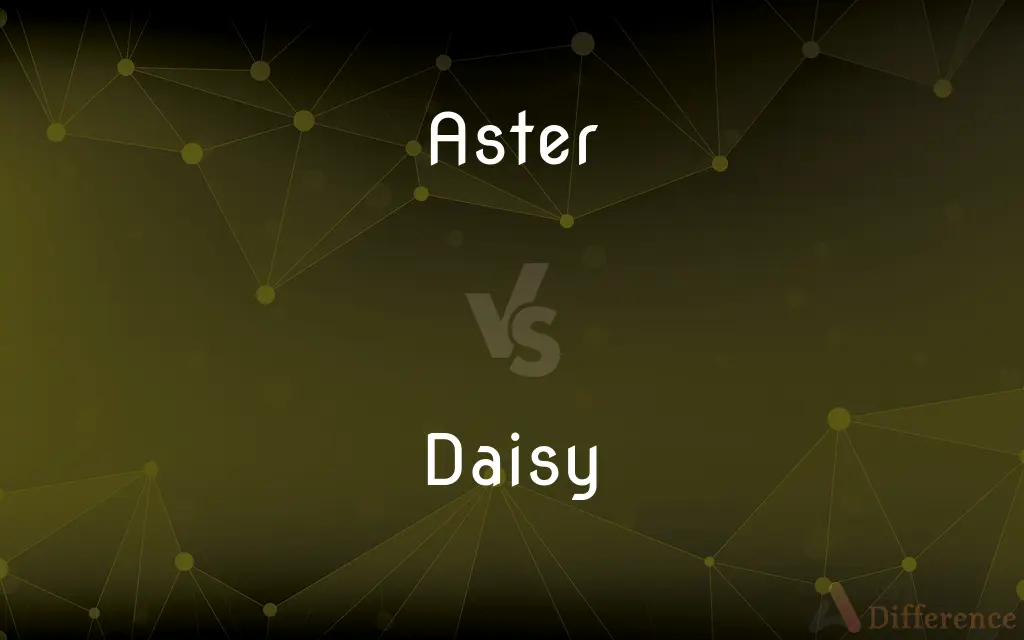Aster vs. Daisy — What's the Difference?
By Tayyaba Rehman & Maham Liaqat — Updated on April 26, 2024
Aster flowers are known for their star-shaped blooms and variety of colors, while daisies typically feature a classic white petal with a yellow center, symbolizing purity and innocence.

Difference Between Aster and Daisy
Table of Contents
ADVERTISEMENT
Key Differences
Asters are a genus of flowering plants in the Asteraceae family, featuring star-shaped flowers, which is where their name derives from ("aster" meaning "star" in Greek). On the other hand, daisies belong to several genera within the same family, most notably the genus Bellis, and are recognized by their iconic white petals and yellow centers.
Asters bloom mainly in late summer and fall, offering vibrant colors during a season when many other flowers have faded. Whereas, daisies are known for their resilience and ability to bloom from early spring through fall, providing consistent beauty throughout the growing season.
The symbolism of asters can vary, but they are often associated with wisdom, valor, and faith. In contrast, daisies are commonly seen as symbols of purity and innocence, and they have been used in art and literature to convey these themes.
Asters are versatile in their use in gardens and floral arrangements, coming in various colors like pink, purple, blue, and red. On the other hand, daisies, with their simpler look, are often used to add a touch of classic charm to both wildflower arrangements and more traditional garden settings.
Asters require well-drained soil and a good amount of sunlight to thrive, and they are generally more susceptible to pests and diseases compared to other garden plants. Conversely, daisies are notably hardy, often requiring minimal care and thriving even in less ideal soil conditions.
ADVERTISEMENT
Comparison Chart
Family
Asteraceae
Asteraceae
Bloom Season
Late summer to fall
Early spring to fall
Color Varieties
Pink, purple, blue, red, etc.
Mostly white petals with yellow center
Symbolism
Wisdom, valor, faith
Purity, innocence
Care Requirements
Well-drained soil, susceptible to pests
Hardy, minimal care needed
Compare with Definitions
Aster
A flowering plant with star-shaped blooms.
The garden was filled with asters, their vibrant petals contrasting the autumn sky.
Daisy
A common wildflower with a yellow center and white petals.
Daisies covered the meadow, dotting the green with white and yellow.
Aster
Known for its variety of colors.
She decorated the bouquet with asters to add a splash of purple and blue.
Daisy
Often represents purity and innocence.
She wore a crown of daisies to symbolize her youthful innocence.
Aster
Symbolizes wisdom and valor.
The aster was chosen for the knight’s crest for its symbolism of valor.
Daisy
Adaptable and resilient in various climates.
The daisy thrives here, despite the unpredictable weather.
Aster
Belongs to the family Asteraceae.
Asters, like many plants in the Asteraceae family, attract a variety of pollinators.
Daisy
Can bloom from spring through fall.
The robust daisies have been blooming since spring.
Aster
Blooms in the fall.
As other flowers wilt, the asters begin their display.
Daisy
Used widely in gardens and floral arrangements.
Daisies bring a classic look to both formal and informal garden designs.
Aster
Any of various plants of the genus Aster or closely related genera in the composite family, having radiate flower heads with white, pink, or violet rays and usually a yellow disk.
Daisy
A widely naturalized Eurasian plant (Leucanthemum vulgare syn. Chrysanthemum leucanthemum) having flower heads with a yellow center and white rays. Also called oxeye daisy, white daisy.
Aster
The China aster.
Daisy
A low-growing plant (Bellis perennis) native to Europe and widely naturalized, having flower heads with white or pinkish rays. Also called English daisy.
Aster
(Biology) A star-shaped structure formed in the cytoplasm of an animal cell during mitosis, having raylike microtubules that surround the centrosome.
Daisy
The flower head of any of these plants.
Aster
Any of several plants of the genus Aster; one of its flowers.
Daisy
(Slang) One that is deemed excellent or notable.
Aster
(biology) A star-shaped structure formed during the mitosis of a cell.
Daisy
A wild flowering plant Bellis perennis of the Asteraceae family, with a yellow head and white petals
Aster
(obsolete) A star.
Daisy
Many other flowering plants of various species, mostly among the asterids.
Aster
A genus of herbs with compound white or bluish flowers; starwort; Michaelmas daisy.
Daisy
(Cockney rhyming slang) A boot or other footwear.
Aster
A plant of the genus Callistephus. Many varieties (called China asters, German asters, etc.) are cultivated for their handsome compound flowers.
Daisy
A genus of low herbs (Bellis), belonging to the family Compositæ. The common English and classical daisy is Bellis perennis, which has a yellow disk and white or pinkish rays.
Aster
A star-shaped figure of achromatic substance found chiefly in cells dividing by mitosis.
Daisy
Any of numerous composite plants having flower heads with well-developed ray flowers usually arranged in a single whorl
Aster
Any of various chiefly fall-blooming herbs of the genus Aster with showy daisylike flowers
Aster
Star-shaped structure formed in the cytoplasm of a cell having fibers like rays that surround the centrosome during mitosis
Common Curiosities
Are daisies easy to care for?
Yes, daisies are known for being hardy and require minimal care.
What are the common colors of asters?
Asters can be found in pink, purple, blue, and red.
What does the daisy symbolize?
Daisies symbolize purity and innocence.
What is the typical bloom season for daisies?
Daisies can bloom from early spring through fall.
Can daisies thrive in poor soil conditions?
Yes, daisies are adaptable and can thrive even in less ideal soil conditions.
Which flower is more susceptible to pests, asters or daisies?
Asters are generally more susceptible to pests compared to daisies.
What family do both asters and daisies belong to?
Both asters and daisies belong to the Asteraceae family.
Do asters require specific soil conditions?
Asters thrive best in well-drained soil.
What is the main difference in the appearance of asters and daisies?
Asters have star-shaped blooms and come in various colors, while daisies typically have white petals with a yellow center.
Which flower is considered more symbolic of innocence?
The daisy is more commonly associated with innocence.
When do asters typically bloom?
Asters typically bloom from late summer to fall.
Are asters used in floral arrangements?
Yes, asters are commonly used in a variety of floral arrangements.
How do the care requirements for asters and daisies differ?
Asters need more care, particularly in terms of soil and pest management, while daisies are less demanding.
How do daisies contribute to garden aesthetics?
Daisies add a touch of classic charm and are versatile in both wildflower and traditional garden settings.
What kind of symbolism is associated with asters?
Asters are often associated with wisdom, valor, and faith.
Share Your Discovery

Previous Comparison
Detailee vs. Employee
Next Comparison
Millennia vs. MillenniumAuthor Spotlight
Written by
Tayyaba RehmanTayyaba Rehman is a distinguished writer, currently serving as a primary contributor to askdifference.com. As a researcher in semantics and etymology, Tayyaba's passion for the complexity of languages and their distinctions has found a perfect home on the platform. Tayyaba delves into the intricacies of language, distinguishing between commonly confused words and phrases, thereby providing clarity for readers worldwide.
Co-written by
Maham Liaqat















































